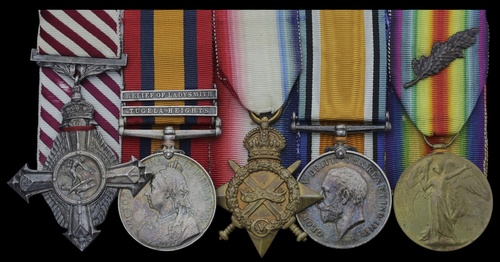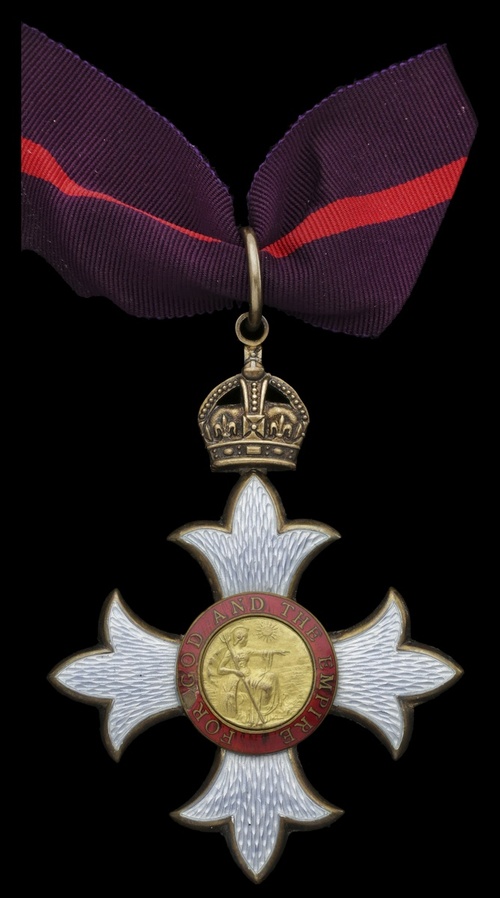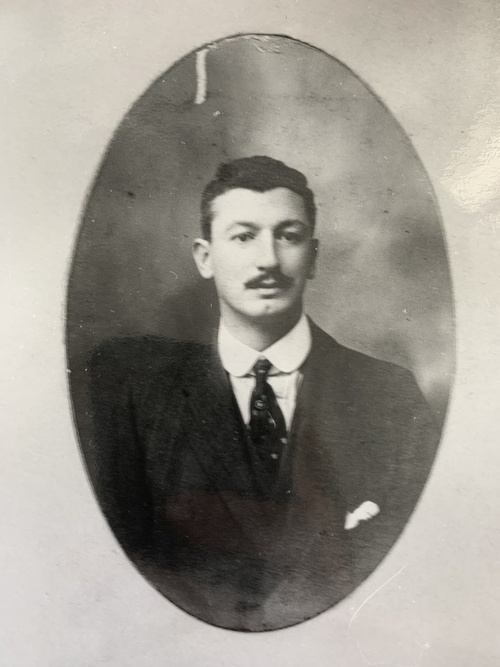Auction: 20002 - Orders, Decorations, Medals & Space Exploration
Lot: 583
A rare Great War C.B.E., A.F.C. group of six awarded to Group Captain J. C. Halahan, Royal Air Force, late Royal Dublin Fusiliers and Royal Flying Corps, who flew operationally in No. 4 Squadron in 1915, prior to becoming a Squadron C.O. and Wing Commander - he is recorded with at least one 'kill'
The Most Excellent Order of the British Empire, C.B.E. (Military) Commander’s 1st type neck badge, silver-gilt and enamel; Air Force Cross, G.V.R., unnamed as issued; Queen’s South Africa 1899-1902, 2 clasps, Tugela Heights, Relief of Ladysmith (Lieut. J. C. Halahan, Rl. Dub. Fus.); 1914-15 Star (Major J. C. Halahan, R.F.C.); British War Medal 1914-20 (Col. J. C. Halahan, R.A.F.); Victory Medal 1914-19, with M.I.D. oak leaves, the breast awards mounted court-style by Spink & Son, naming erased on this last, contact marks, nearly very fine and better (6)
C.B.E. London Gazette 1 January 1919.
A.F.C. London Gazette 3 June 1919.
John Crosby Halahan was born in 1878, one of six sons of Surgeon-Colonel Samuel Halahan of Sydenhurst, Chiddingford - two of whom went into the Royal Navy, two the Army and two the Royal Air Force. Young John, like his brothers, was educated at Dulwich College, and commenced his military career on appointment as a 2nd Lieutenant in the Royal Dublin Fusiliers in May 1899. They as a family provided more Old Alleynians to the Forces than any other. Quickly witnessing active service in South Africa, where he was present in the relief of Ladysmith operations and at Val Krantz, Pieter’s Hill and the Tugela Heights (Medal & 2 clasps), he gained advancement to Lieutenant in February 1900.
Appointed Adjutant of the 4th Battalion in March 1907, Halahan was advanced to Captain in June 1908 and placed on the Reserve of Officers in June 1912, following which he gained attachment to the fledgling Royal Flying Corps and took his Royal Aero Club Certificate (No. 354) in October of the same year.
Following the outbreak of hostilities, Halahan went out to France as a pilot in No. 4 Squadron in August 1915, flying the unit’s B.E. 2s in a reconnaissance and bombing role, and, as verified in R.F.C. Communiques of the same year, quickly fought his first combat:
‘11 September 1915: Captain Halahan (pilot) and Lieutenant Evans (Observer), No. 4 Squadron, in a B.E. 2c with Lewis gun and rifle, when on reconnaissance north of Bapaume were attacked by a hostile machine, probably an Aviatik, which bore down on the left rear of the B.E. 2c firing from a distance of half a mile. It was this premature opening fire which attracted the attention of Captain Halahan, who put his Observer on the alert. About half a drum was fired at the Aviatik, which sheered off and flew round the B.E. 2c being much faster: during this the Observers were firing at one another. After a short time the German threw overboard two silver balls which burst into a shower of white puffs. Thinking this was a sign to the A.A. guns giving the height of his machine, Captain Halahan dived to 200 feet when seven shells burst just above and all round his machine. After further shooting between the aeroplanes, the German dived and went quickly to ground in a long circular glide, landing in a field three miles south of Bapaume.’
And the same source reveals another combat fought by Halahan in the following month:
‘28 November 1915: Captain Halahan and Captain McLeod, in a B.E. 2c of No. 4 Squadron, while taking photographs of Clery, and the Observer doing a special reconnaissance, encountered a Fokker about 200 yards away. The enemy approach was at first unnoticed, but the Lewis gun was soon brought to bear on him and the B.E. 2c headed straight for him. The enemy, after a few rounds, turned sharply to his left and headed for Peronne, followed by the B.E. 2c. The hostile machine eventually disappeared apparently without sustaining damage.’
Halahan, who also participated in some of the earliest bombing raids of the War, departed No. 4 Squadron at the end of the year, but returned to France as C.O. of No. 12 Squadron at Avesnes-le-Comte in 1916, as part of Twelfth Wing, III Brigade, and subsequently commanded it throughout the Somme operations. In the following year, Halahan served as C.O. of No. 39 (Hainault Farm and North Weald) and No. 78 (Telscombe Cliffs) Squadrons, while in August 1917 he was appointed Wing Commander of No. 50 Wing and, in March 1918, No. 48 Wing, most of these senior commands being on the Home Establishment. He was awarded the C.B.E. and A.F.C. and attained the rank of Group Captain before being placed on the Retired List. During the Second War he served with the Colonial Office and he died on 22 February 1967.
His only son, Squadron Leader P. J. H. “Bull” Halahan, gained fame as C.O. of No. 1 Squadron out in France in 1939-40. Any interested party would enjoy reading Fighter Pilot, by Paul Richey, a member of No. 1 Squadron to learn more of the exploits of "Bull" and his men.
Sold together with copied research including portrait photograph and his Aero Licence.
Subject to 20% VAT on Buyer’s Premium. For more information please view Terms and Conditions for Buyers.
Sold for
£2,800
Starting price
£1600









